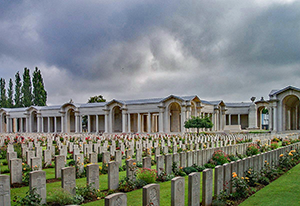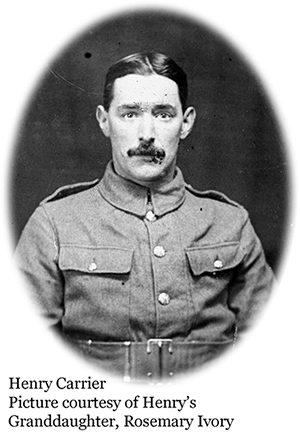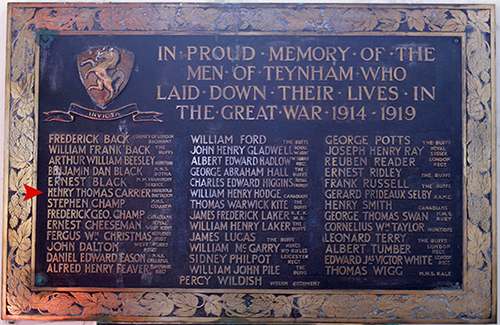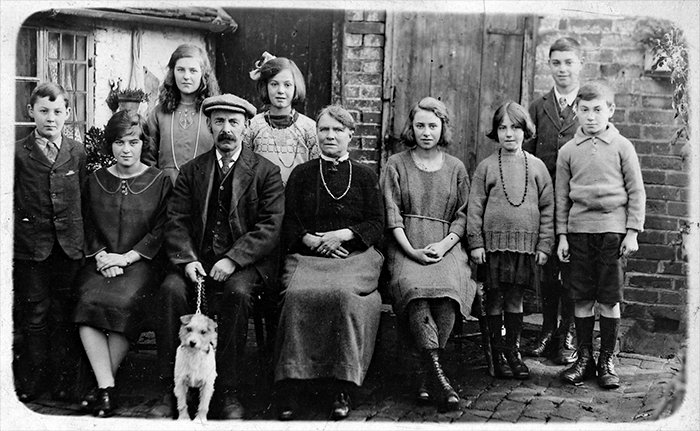First World War Project
Henry Thomas CARRIER (of Lynsted)
b. 17 November 1885 Trooper, Service Number 1737 |


Son of Henry Julius, a garden and orchard labourer, and Elizabeth Jane (née Gage), Henry Thomas was born in the house next door to Newhouse Farm, Greenstreet, Lynsted, on 17 November 1885. He was christened in Teynham Church on 16 December. Along with Henry's younger sister, Harriet Jane, the family had also lived in Cellar Hill and Wilkin's Cottages in Greenstreet, Lynsted.
Henry Thomas worked as a butcher's assistant in Mr Wilkin's butchers shop in Greenstreet. In later years this became Read's butchers and is now converted to accommodation.
In addition to his day job, Henry served in the Greenstreet Division of the St. John Ambulance Brigade, and in the Teynham and Lynsted Fire Brigade.
On Christmas Day 1907, at the age of 22, Henry married Alice (née Banning), daughter of Albert, a ship riveter living in Chatham, and Bertha (née Field), in Lynsted Church.
At the time of the 1911 Census Henry and Alice were living in Green Villa (now 92 London Road), Greenstreet, and had a daughter, Isabella Evelyn (known as Evelyn), born on 31 December 1909. Four further children would be born, Henry Albert on 29 April 1912, Ruby Alicia Banning on 4 July 1913, Ronald Kitchener on 7 May 1914 and Joan Kathleen on 27 February 1916.
Henry enlisted in Sittingbourne on 11 December 1915 into the Royal East Kent Mounted Rifles (REKMR). At the time of his enlistment the family were living in "Rose Lea", Greenstreet. He was immediately put into reserve. On 9 June 1916, he was called up and posted to the REKMR 3/1st. On 28 October 1916 Henry was transferred in to Household Battalion Reserve, which was then training at their barracks in Windsor, and given the new rank of "Trooper".
Up until this point, Henry's military career coincided with that of William Gambrill. Henry and William enlisted, trained and were transferred to the Household Battalion together. They had consecutive regimental numbers during their time in the REKMR, and were just a few digits apart on transfer to the Household Battalion. However, their stories, for a while, went in different directions when William left for France on 8 November 1916.
Henry continued with his training until his posting into the Household Battalion proper on 3 February 1917, when he immediately embarked for France from Southampton. The following day he disembarked in Le Havre and Henry and William's stories then coincide again and are detailed in the previous biography.
William was killed on 3 May 1917 but Henry would live for a further 8 days. Despite the battalion being heavily under strength, the sixth and final attack on Roeux began. The attack was preceded by the heaviest bombardment seen since the start of the battle on 3 May. Smoke shells gave a screen which prevented a clear picture of the attack from Battalion Headquarters. The infantry moved off at 7.30pm and the troops were ordered to attack the area around the railway station and the land to the north, while other units attacked the village itself. The story of his remaining days are detailed in the Household Battalion war diary:
| Date | Summary events and Information |
| 4th May 1917 | Reorganisation of Line. Pioneers (W. Yorks) assisted ahead of Seaforths were completed from I.19.e.7.5. to I.19.B.1.2. in lien with West corner of CEMETERY. |
| 5th | Very quiet. Sniping active at night. Posts deepened. |
| 6th | 3 a.m. Bombing attack by 2nd Lieut. Wanklyn on enemy Listening Posts I.19.c.6.05 after excellent reconnaissance by 2nd Lieut. Moffat causing German retaliation along whole line. |
| 7th | Relieved in line by Royal Irish Fusiliers. Battalion came back to 4th German system H.22.A.a.3. |
| 8th | Battalion reorganised into 5 platoons. Colonel Postal (?) arrived at Transport. |
| 9th | Battalion rested. |
| 10th | Battalion proceeded up line to original position in front line. Battalion H.Q. at [Green?] Trench (H.24.D.8.9.). Battalion occupy left of original front line. East corner of MOUNT PLEASANT WOOD (I.19.A.9.1.) and junction CEYLON and Front line. |
| 11th | Battalion took part in attack on CEMETERY. 7.30 p.m. Objective to dig in East of N. end of village. Officers: Capt. Tobin (?). 1 Platoon Lt Bridgeman; 2 Platoon 2nd Lt. Price; 3 Platoon 2nd Lt. Stockwood; 4 Platoon 2nd Lt Wanklyn. H.Q. Major Kirkwood. Lt. Dill – Cazalet – Sandeford - Capt. Sloan R.A.M.P. Attack successful. Seaforths mopping up in rear of Battalion Royal Irish Fusiliers on right. R.W.A. in reserve. Casualties again very heavy – 2nd Lt Stockwood only officer in line. |
On 16 May, Major J.H.M. Kirkwood of the Household Battalion wrote his narrative of operations undertaken on 11/12 May:
At 5.30 p.m. on Z day I moved my Battalion H.Q. up to the head of CEYLON trench near the Junction with CAP. Here I established a telephone line in connection with the Brigade Report Centre. I also took Lieut. Cazalet forward as Intelligence Officer leaving Lieut. Dill with the greater part of the H.Q. staff at Battalion H.Q. in CRUMP dug-outs.
At 6 p.m. I went round the line and found the whole situation satisfactory – Officers and men keen and confident. Captain Tobin commanding the whole line, which was divided into 4 platoons, total 5 officers and 177 O.R.
At Z hour (7.30 p.m.) I was able to obtain an excellent view of the commencement of the attack and the men went forward in very good order – scarcely one seemed out of place – though I consider that in places the barrage was falling rather short and this caused my left platoon No.1 to bear away to the left after they had worked up close to the barrage – otherwise I saw no fault in the line up to the time that I lost them to view in the smoke.
At Z plus 5. I saw several prisoners come running back through the smoke towards Mr. PLEASANT WOOD.
At 8.15 p.m. Captain Tobin came by wounded, but informed me that all was going well.
At least 50 prisoners had passed my H.Q. by 8.15 p.m.
A message brought in at 8.45 p.m. stated that my left platoon (No.4) as well as part of No.3, had gained its objective and was consolidating.
At 8.50 p.m. Lieut. McPherson of the Seaforths, who had been forward to clear up the situation (he did very valuable work during the night) returned to report that my left was alright; but that my right centre and right were held up in the gardens round the Cemetery and were being enfiladed by M.G. fire from the houses – he also informed me that there appeared to be a wide gap on again from there to the R. Irish Fusiliers. The Seaforth mopping up party had mostly returned to the trench which ran West of the Cemetery across our front – this they were consolidating.
9 p.m.: I sent Lieut. Cazalet down at once to R. Warwickshire H.Q. to inform Colonel Forster, and asking him if I might use his front line Companies to strengthen the position and gain our objective.
I had been told that I should not use the troops holding our front line excepting in the case of a counter-attack and then only if very urgently needed.
Consequently I did not feel justified in using them unless I received the consent of the O.C. Royal Warwickshire Regiment and the Brigade.
9.21 p.m. I received a reply back that I was to send forward "B" Company Royal Warwickshire Regiment (this amounted to less than 30) and that one company of the King's Own were coming up to reinforce the front line. I then directed O.C. "B" Company R.W.R. to advance at once, and support my right and right centre in the direction of the CEMETERY. This order was send off in writing at 9.30 p.m.
9.33 p.m. I sent a runner off at the same time to 2nd Lieut. Stockwood who was the only officer whom I could ascertain to be in the advance line, telling him that support was being sent up to his right.
9.57 p.m. A further message from O.C. R.W.R. arrived at 9.57 p.m. saying the his "C" Company was being sent up to establish communication between my left and the Hampshire Regiment who were co-operating on the left of the 10th Brigade. Immediately on receipt of this I sent off a message in reply to say that all reports gave me to understand that we were linked up on the left and that my right was far more in need of support. This message I sent off at 10.2 p.m. but in the meantime "C" Company R.W.R. had already been despatched (I might here add that this rather pointed to overlapping, as I had been previously given to understand that all 3 Companies of R.W.R. were under my orders, and I was relying upon this in order to be able to deal with any urgent call for support – more especially as each Company of R.War.R. was less than a full platoon strength.)
9.50 p.m. I heard from my right centre platoon that they had pushed forward and got in touch with the two left platoons, but had been entirely cut off from the right platoon. I gathered that the combination of the darkness and fairly heavy machine gun fire from houses in the neighbourhood of the cemetery had accounted for this.
At 10.38 p.m. I sent a message to O.C. SKEW, which message I repeated to the Brigade Major on the telephone (This was of very little use to me as the line was frequently broken during the night) to say that I was confident of holding the objective gained and of consolidating the entire position providing that supports were sent to me to operate after moonrise or before dawn as the darkness rendered any attempt to straighten things out futile.
About this time I heard that part of "B" Company R.W.R. had run into machine gun fire and got separated, 14 of them had returned to the front line and the remainder (as I learnt later) had joined their "C" Company and had consolidated on our left in touch with the Hampshire Regt, although I should have preferred their assistance on my right.
At 11.55 p.m. I received a message from O.C. R.W.R telling me that if I utilized his remaining men, that he would send the Company of King's Own up to occupy our front line in place of them.
At 12.35 a.m. I heard from Lieut McPherson that three of the machine guns that were to have been with my advanced troops, if they took the objective were back with the Seaforths and that only one was up in my front line on the N.E. of the CEMETERY.
At 1.5 a.m. I heard through a runner from 11th Brigade that all their objectives had been taken.
About this time the Brigade Major 10th Brigade arrived at my H.Q. and I told him that I felt confident about holding the position providing I could obtain enough men to send forward before dawn to capture the houses on the road round the Cemetery and I asked him to let me have at least 50 men of the King's Own as well as the remainder of the R.W.R. This he agreed to do.
I then sent a further message to Lieut. Stockwood to hold on and to consolidate as energetically as possible. There was some delay before the O.C. "A" Company, R.W.R. and King's Own arrived; in the meantime I sent a message to O.C. 10th Brigade M.G. in the Seaforth trenches, which I append.
At 2.45 a.m. the Officers commanding detachments of R.W.R. and King's Own arrived, and I gave them the appended orders – This left 50 men of the King's Own to hold the front line and trenches in support.
At 4.30 a.m. I received a message through the Seaforths that both their parties had reached the houses round the Cemetery and Cross Roads and were clearing them.
At 4.54 am everything appeared quiet in the houses from what I saw personally and I sent a message through to the O.C. King's Own advanced posts to establish communication with my right beyond the Cemetery.
At 5 am I went up to the line held by my men and found all their posts had been consolidated and that they had established connection with the R.W.R's on their left and the King's Own on their right – but it appeared to me that the houses in rear of our line, South of the Cemetery were still held by the enemy as I noticed flares being sent up from that direction in response to two enemy aeroplanes that were flying low over our line and firing very lights. I told Lieut. Stockwood to send two bombing parties to clear up some of the buildings directly he was able to find the available men. About 5.30 a.m. as I was returning to CEYLON trench via CORONA, I met the Brigade Major, 10th Brigade and told him that the situation was satisfactory, excepting the clearance of the houses in question, and pointed out that we had not enough men to clear up the situation. He suggested that the Seaforths should send a strong detachment forward as bombing parties and I agreed that it was the best possible solution. Captain Booth of the Seaforths was then instructed to go forward to clear the vicinity of the Cemetery at the same time as the 11th Brigade attacked the BLUE Line, viz 6.30 a.m.
This was most effectively done and some 5 Officers and 60 O.R. were taken prisoners.
After this, everything quietened down, and the line was strengthened and consolidated.
During this engagement the enemy barrage was more prolonged than during the operations of May 3rd/4th, and continued several hours.
Casualties during the action:–
| Officers | Other Ranks | |
| Killed | 1 | 3 and 1 died of wounds |
| Missing | 2 | 22 (includes 1 wounded) |
| Wounded | 1 | 68 |
| Total | 4 | 94 |
Henry had not lived to see the success of the battle. The following morning all the objectives to the north of the railway were taken, and the western half of the village had been occupied. During the day, efforts were made to consolidate the ground and that night the Germans were forced out at bayonet point, allowing the line to move forward to the eastern half of the village.
On 30 May 1917, Henry was officially posted as "missing" since 11 May and his wife informed. The following year, on 23 February 1918, Henry was officially classed as "killed in action on or after 11 May 1917". His wife, now living at 18 Station Road, Teynham, was informed on 27 February 1918.
The following week a report was published:
| East Kent Gazette of 2nd March 1918 |
TROOPER H.T. CARRIER, LIFE GUARDS Mr. and Mrs. H.T. Carrier [sic], of 18 Station road, Teynham, were informed some time ago that their son [sic], Trooper H.T. Carrier, of the Household Battalion, was posted as missing on May 11th, 1917. Since then nothing has been heard of him, and the parents hope that by means of a portrait, some of his former comrades will be able to give some information as to what happened to him. Trooper Carrier enlisted on June 8th, 1916, up to which time for some years he had been in the employ of Mr. Wilkins, butcher, of Greenstreet. After completing his training he went to France on February 3rd 1917. On May 11th he took part in a third, and this time successful attack on the village of Roeux. A good many men of Trooper Carrier's company were cut off and taken prisoners." However, notwithstanding inquiries made at almost all sources, no tidings have been received. Trooper Carrier is a married man, his wife being formerly Miss A. Banning, eldest daughter of Mr. and Mrs. Albert Banning, of 26, Institute road, Chatham. |
On 9 March 1918, they followed up with the following report:
| East Kent Gazette of 9th March 1918 |
| TROOPER H.T. CARRIER, LIFE GUARDS We published a photograph last week of Trooper H.T. Carrier, of the Life Guards, who had been missing for many months. Mrs Carrier, the wife of the young trooper (not the mother which we stated in error last week), then desired that any information relating to her husband might be sent to her. Since our publication last week, however, the Army Authorities have advised Mrs. Carrier that her husband was killed on May 11th of last year, or since that date. Trooper Carrier was a most useful resident of Greenstreet, for he was a trained member of the Greenstreet Division of the St. John Ambulance Brigade, and also a member of the Teynham and Lynsted Fire Brigade. He was greatly respected in the village, and much sympathy is felt for the bereaved widow and children, and also for the young man's parents, who reside in Greenstreet. Mrs Carrier hopes that if by chance the news of the death of her husband reaches any of his late comrades who saw the last of him, she would be glad if they would communicate with her at 18 Station road, Teynham. |
Henry's body was never identified. He is commemorated on the Arras Memorial, Pas de Calais, France. Bay 1. As well as the Lynsted memorial, he is also remembered on the Teynham war memorial.

In addition, Henry and William Gambrill, are listed in one of the three books of remembrance in the Holy Trinity Parish and Garrison Church, Trinity Place, Windsor, the Garrison Church of the Household Cavalry, Household Battalion and the Brigade of Guards. The books contain 14,000 names of those who fell from the Brigade of Guards. Altar rails were put up in memory of those of the Household Battalion who fell in the Great War, 1914-1918.
Henry was posthumously awarded the British War Medal and the Victory Medals [See Appendix 1].
In January 1918 Alice was awarded a widow's pension amounting to £1 11s 6d a week. In today's money around £96. In July 1918, she received Henry's owed pay of £6 9s (£6.35p). In October 1919 she also received his War Gratuity of £3. [See Appendix 2] Taken together these amount to roughly £546 in today's money.
Henry's ultimate sacrifice left a widow, and five children. Alice's post war story is not a happy one and illustrates the physical and emotional hardships that faced those who were left behind.
Alice had tried to supplement her income by working as a cashier in the Co-operative Society. Sadly, as 1919 dawned Alice was in dire straits. The following report explains:
| Faversham and North East Kent News of 25th January 1919 |
NEGLECT OF CHILDREN AT TEYNHAM The Faversham County Justices had a shocking story of the condition of a home described to them at the Sessions on Thursday in last week, when Alice Carrier, who lives at 18, Station Road, Teynham, and who has lost her husband in the war, was summoned for neglecting her five children (ranging in age from 9 to 3 years) in such a manner as to cause them unnecessary suffering and injury to their health. From the evidence of Inspector Ryley, of the RSPCC, it appeared that when he visited the house on January 2nd he found the children very inadequately clothed, while the whole place was in an inconceivably disgusting state. Three of the children had no underclothing on whatever, two girls wearing only a dress and a boy an overcoat. The other two children were not much better off. There was very little furniture in the house. Defendant said she had been ill and unable to attend to the place. The Inspector gave her a few days grace to clear up but when he called again on the 6th, she had done nothing, though the children had a little more clothing on. The place was as disgustingly filthy as before. He then called in Dr. Selby on whose instructions the children were removed to the Guardians' Institution. The children themselves were fairly clean and well nourished. Defendant had been in receipt of a pension of £1/17/11 per week, subsequently increased to £2/4/6. She had had no money since December 28th, but this was entirely due to her failing to send an identity certificate. Dr Selby said he had never seen anything to equal the state this house was in; it was shocking. The conditions were certainly injurious to the children's health and must have caused them suffering. Defendant, who had pleaded guilty to the charge, said she was ill with influenza and the children had to look after themselves. She appealed for help to her husband's people, but it was refused. For a time she acted as cashier at the Co-operative Stores, but had to give that up owing to the children. She had always worked hard, and the house would not have got in such a state if she had been well. Dr Selby said that though it was a bad case he wanted the woman to have another chance. He would undertake to find some bedding, and probably the Guardians would provide some clothes for the children. In any case he hoped the Bench would make an order giving the Health Visitor the right of entry to the house. The Chairman said the Bench would not have hesitated to send the defendant to prison if the doctor had not appealed on her behalf. Under the circumstances they would give her another chance and bind her over in the sum of £20 to come up for judgment if called upon within the next twelve months. She would also be placed under the supervision of the Probation Officer and the Health Visitor would have the right of entrance at any time. Defendant, who was neatly dressed in black, said she had not cleaned the house up thoroughly. She assured the Bench it should never get in such a state again. The Chairman told her she could consider herself generously treated." |
Times were difficult for the Carrier family as they had not only lost Henry, but his sister Harriet has also lost her husband, Thomas Wigg, when when HMS Kale his a mine on 27 March 1918 (Thomas is also commemorated in this project). Harriet took up work on the and to support her three children.
In 1921, Henry's widow married William Austin of Teynham. She died in 1956.
Henry's mother and father are seen in this photograph along with some of the children of Henry and Thomas Wigg.

Carrier and Wigg families (About 1926) Greenstreet
Back Row: Edith R Wigg, Ruby Carrier, Henry Carrier.
Front Row: William Thomas Wigg, Margaret Harriett Wigg, Henry Julius Carrier, Elizabeth Jane Carrier (née Gage), Isabella Evelyn Carrier, Joan Kathleen Carrier, Ronald K Carrier
Photograph by kind permission of David Kerrall
The Society is indebted to Mrs Rosemary Ivory, Granddaughter of Henry Thomas Carrier and Thomas Wigg for her valuable contribution to Henry's story.

 World War 1 Pages
World War 1 Pages